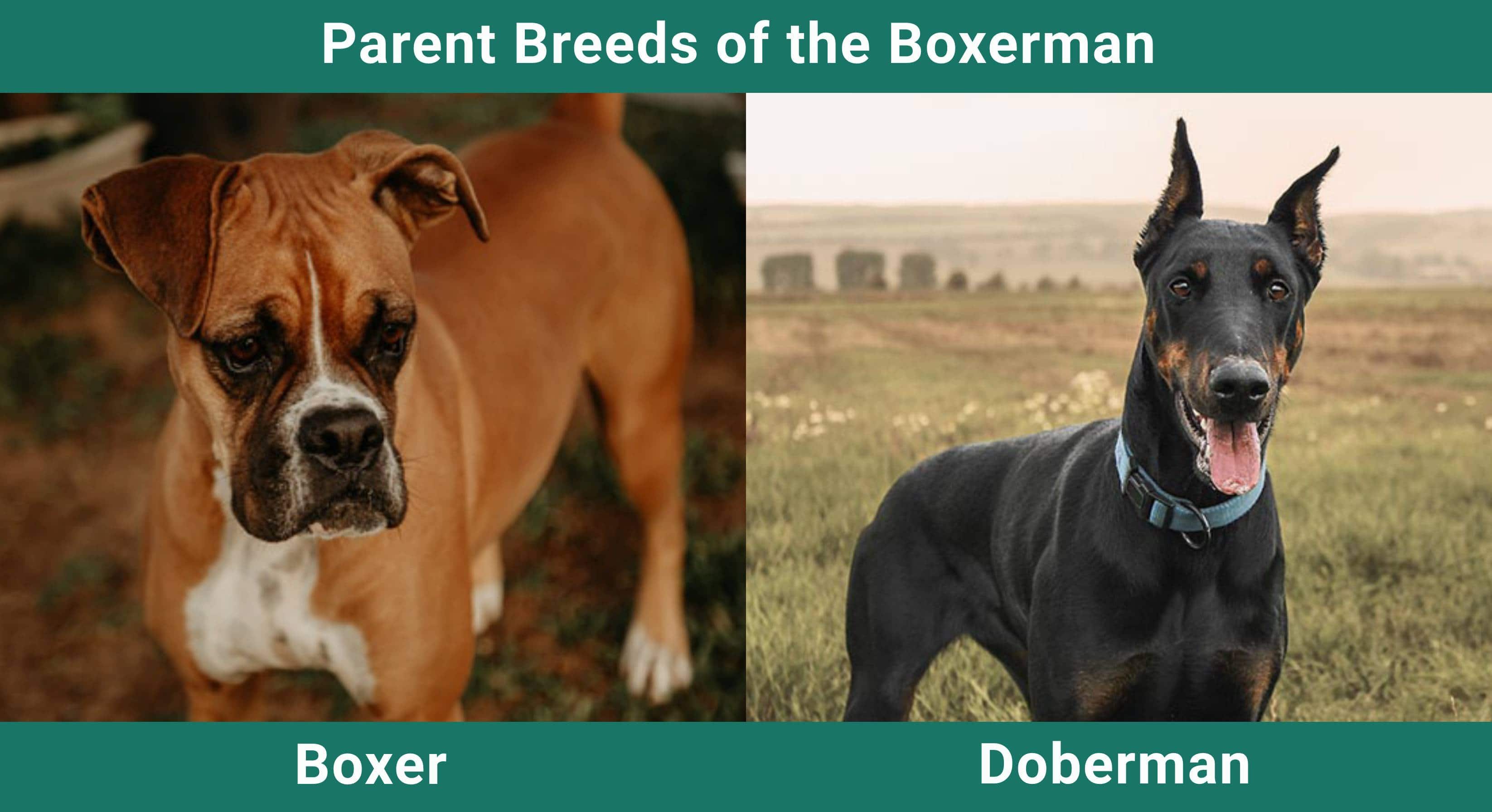Click Below to Skip Ahead
The Boxerman may seem like an anomaly. They have the undeniable cuteness of the Boxer combined with the no-nonsense attitude of the Doberman. It sounds odd but it works! The former is an old breed, with a history that belies their looks. They were once a formidable hunter and fighter, hence their name. The latter was equally tough as a companion to tax collectors back in the day.
Breed Overview
Height:
21 – 28 inches
Weight:
50 – 90 pounds
Lifespan:
10 – 12 years
Colors:
White, brindle, black, fawn, red, blue
Suitable for:
Active families looking for a low-shedding pet and watchdog
Temperament:
Loyal, intelligent, friendly, alert
The origins of the Boxerman are unknown. They’re not recognized by any of the hybrid dog associations, although you can register them with the Dog Registry of America. This pup is a loving pet that is relatively easy to care for and a quick learner. That makes them ideal for the experienced dog owner. Both parent breeds bring health issues to the table, though.
Boxerman Puppies
Every dog has some unwanted traits. However, many of these are controllable if you get a puppy that is at least 8 weeks old and has had valuable socialization time with their mother and littermates. The Boxer in your pup has a relatively high prey drive due to their hunting past. That also fuels their wanderlust potential and tendency to bark.
The Boxerman is a large dog. It’s essential to establish a strong owner-pet bond right away to make training easier for you. It’s also worth noting that neither parent breed is tolerant of being alone for long stretches. That’s their loyalty coming to the surface. They are affectionate with their human companions and want to spend time with them. That also means a commitment on your part.

Temperament & Intelligence of the Boxerman
The easygoing nature of the Boxer and the intelligence of the Doberman make the Boxerman easy to train. They are loyal dogs that will form strong bonds with their owner. They also are more sensitive to harsh words than you may think. Positive reinforcement is the best way to handle a Boxerman. They’re not pups that you should leave alone for long stretches.
Are These Dogs Good for Families?
The Boxerman will make a welcome addition to your home. They are affectionate pets that can make excellent watchdogs. We suggest supervising playtime with younger children just because of the size of this pup. Both parent breeds have a high potential for playfulness. The intensity of the Boxer may overwhelm smaller kids.
Does This Breed Get Along With Other Pets?
The size and prey drive of the Boxer might prevent getting along with other pets. A fleeing cat is sure to trigger a chase. Early socialization is imperative if you already have a dog. It’s also the best way to avoid other unwanted behaviors, such as fearfulness. We suggest enrolling your pet in puppy playtime classes as soon as you get them.
Things to Know When Owning a Boxerman
Owning a larger dog is more of a training commitment because of their size. It also means more attention to exercise, training, and diet because both parent breeds have a tendency to get overweight. Fortunately, the Boxerman is an energetic dog, which will help on that score. However, there are several other things to consider with this particular mix.
Food & Diet Requirements
It’s essential to feed your Boxerman a high-quality diet with food formulated for larger breeds. Their needs are different from smaller dogs, which mature more rapidly. It’s also vital to give your pup a diet meant for their life stage. Puppies need more protein and fat than adult dogs to support their growth and development.
We suggest feeding your pup three or four small meals a day and gradually cutting this down to two times a day as an adult. Both parent breeds have a heightened risk of bloat, which can occur if they gulp down their food and swallow too much air. Feeding them multiple meals makes this less likely to occur. It will also keep their blood sugar stable throughout the day.
Exercise
The Boxer is the more energetic of the parent breeds. That will mean daily walks to keep your pet active and help avoid obesity. A walk will also provide adequate mental stimulation, which is vital for intelligent pups like the Boxerman. It’s an excellent opportunity to practice their socialization skills and expose them to new people, dogs, and situations.
Training
It helps that both dogs have an eagerness to please. However, that also means that you must be a strong leader when it comes to training. Treats are excellent motivators and will foster a positive training experience with your Boxerman. We suggest limiting them to no more than 10% of your pet’s diet, though.
Grooming ✂️
The Boxerman will shed frequently, despite their short coat. We recommend weekly brushing to keep the hair under control. It’s also an excellent way to reinforce your bond with your pet. You should also check their ears regularly, especially if they are not cropped. The same advice applies to your pup’s nails. We suggest handling their paws frequently to get them used to having them touched.
Health and Conditions
Both the Boxer and the Doberman bring a host of potential health issues. We recommend buying from reputable sellers who do pre-breeding screenings. This also makes regular vet care imperative. It’s the best way to identify issues early before they can affect your pet’s quality of life.
- Cataracts
- Hypothyroidism
- Obesity
- Degenerative myelopathy
- Cardiomyopathy
- Bloat
- Hip dysplasia
- Heart issues
- Von Willebrand’s disease
Male vs. Female
There is considerable dimorphism, or body differences between males and females, in the parent breeds. This is likely the case with the Boxerman too. The personalities of the two are similar, though. The other thing is the cost of spaying or neutering your pet.
The surgery for females is considerably more expensive and risky than that for males. The reason is that it’s more invasive, which raises the chances of post-operative complications. Research has also identified a few health problems with opting to alter the sex of your pet. We suggest discussing it with your vet.
3 Little-Known Facts About the Boxerman
1. The Boxer’s History Goes Back Thousands of Years.
The Boxer began life over 4,000 years ago as a hunter in the Assyrian empire. Their quarry was big game, such as wild boar. It required a fierce and determined dog. The breed’s docile nature belies this fact.
2. The Boxer Is Appropriately Named.
The name Boxer brings up thoughts of being tough and a strong competitor. The pup’s unfortunate past in fighting speaks to these ideas. It also refers to the way that this dog fought in the ring: using their front paws in the form of kangaroo boxing.
3. The Doberman Has a Heroic Past.
You may think of the Doberman as a police dog, which indeed, they were in the past. The breed also served in the military, where they earned high honors for their service during World War II.
Final Thoughts
It’s hard not to fall in love head over heels with the Boxerman. They have the expressive face of the Boxer, with the staunch loyalty of the Doberman and their muscular body. They are a robust dog with enough energy to keep up with the kids. While there are potential health problems, regular vet care will help prevent these from becoming issues.
See Also:
- Vizsla Doberman Mix: Care Guide, Pictures, Traits & More
- Boxer Vizsla Mix: Care Guide, Pictures, Temperament, & More
Featured image credit: Nick Chase 68, Shutterstock










